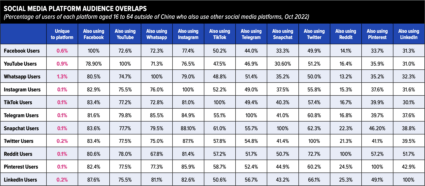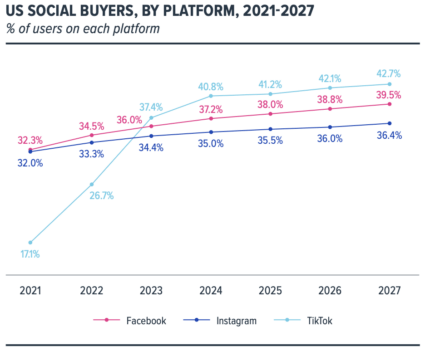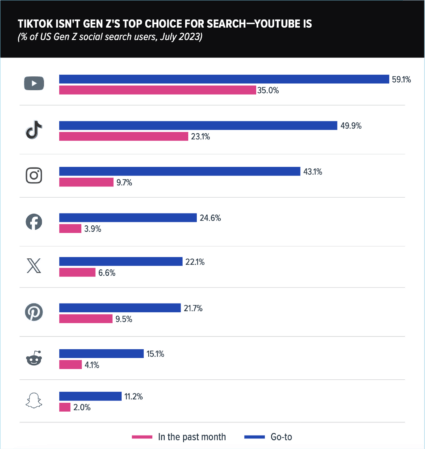The day many marketers have feared is here: the bill that could result in a TikTok ban has been signed into law. The new legislation gives ByteDance, the platform’s Chinese parent company, nine months (plus a potential three-month extension) to sell the app or face a nationwide ban.
A sale of a platform worth billions of dollars would be difficult in such a short window, even if ByteDance didn’t need the blessing of the Chinese government to part with TikTok’s famous algorithm. But that doesn’t mean a ban is a sure thing, or even likely; ByteDance has promised to fight the new legislation in court, and other entities like the ACLU have expressed opposition to the law and could also end up going head-to-head with the government through the judicial system.
It’s also clear that the government doesn’t want to ban TikTok; their goal is divestment. Legislators fear that the Chinese government could force access to data from TikTok’s 170 million American users or use the platform to influence users by suppressing or promoting certain content. But those same legislators (as well as the White House) are well aware of TikTok’s spectacular popularity with the voting public—and how unpopular an outright ban would be.
So where does that leave brands? First, don’t panic: no outcome is assured right now, and the likely court cases mean any real effects won’t happen for quite a while. You should not be making any moves to shut your TikTok strategy down. But you do need to start thinking about the role TikTok plays in your media mix so you can future-proof your overall social strategy and prepare to weather any potential changes to come.
The value proposition: analyzing TikTok’s role
You should start this process by articulating what the platform does for your brand right now.
TikTok has a major, growing audience: According to Kepios, 18.7% of all people aged 18 and up around the world use TikTok. It has over 170 million monthly active users in the US alone, so at least some of your target audience is almost certainly on the app and engaged. The app has a reputation for reaching young audiences, and the platform’s fastest-growing segments are indeed the coveted 18-34 demo. But TikTok isn’t limited to teenagers these days; the 45+ audience makes up about 13% of the user base.
In the unlikely event that TikTok goes dark at some point in the future, there is significant user overlap with other social media platforms. Hootsuite’s 2023 social trends report found that only 0.1% of TikTok users only use TikTok. The platforms with the biggest user overlaps are Facebook at 83.4%, Instagram at 81%, and YouTube at 77%.

Source: Hootsuite
But you also need to consider what your target audiences are using the platform for. The platform is one of the most powerful tools on the planet for product discovery: Saatchi’s 2023 TikTok report found that 62% of TikTok users say they are most likely to discover new things on TikTok over any other social platform or search engine. That’s why many brands focus their TikTok strategies on upper-funnel objectives like awareness or affinity.
If your brand is leveraging TikTok to grow the upper funnel and generate awareness and demand, you should consider what other channels your audiences are using to find new products or brands or recommendations from peers: Reddit, Instagram, Snapchat, and YouTube are all part of many users’ purchase journeys. Carefully monitor your data to uncover those learnings and keep testing new channels to find the right ones.
Further down the funnel is TikTok Shop, which lets users make purchases in the same place they were inspired to buy and can accelerate conversions. It’s a growing part of the larger trend toward social commerce, But TikTok isn’t the only social platform looking to make the purchase process more seamless.

Source: eMarketer
Meta has Instagram Shop, which lets brands set up a customizable digital storefront that lets users shop directly from photos and videos, and Meta, Snapchat, and Pinterest have recently partnered with ecommerce heavyweight Amazon to make purchasing (through Amazon) in their apps easier.
The perfect mix: diversifying your social strategy
Diversification is always important, but these new challenges to TikTok underline the need to get more serious about evaluating the strength of your media mix as a whole. If you’re overly dependent on one or two channels, you are putting your brand at risk in a digital media ecosystem that is always changing. Your approach should include a healthy mix of channels aligned with your overall goals and the right combination of upper-funnel and lower-funnel campaigns to fuel long-term growth.
Many performance-oriented brands tend to overindex in the bottom funnel and often fail to sufficiently diversify the media mix, instead concentrating investment in a couple of well-known channels. Don’t starve the upper funnel: build your brand from the top to increase your overall reach, get more people into the conversion stage, and lower the risk of audience exhaustion by constantly refueling your retargeting pools.
Start evaluating your social media mix by asking yourself the following questions:
- Does my brand have over 75% of its social media budget invested in a single platform?
- Is our audience on social channels my brand isn’t investing in?
- Are we adequately filling the upper funnel or is my brand overindexed on direct response?
- Does my brand have a testing strategy in place to try out new channels and campaign types?
- Are we making decisions about social spend based only on granular performance KPIs and efficiency metrics?
- Are we making decisions about channel mix based mostly on targeting and attribution capabilities vs. potential to drive discovery or purchase?
- Are we seeing diminishing returns on our social investment?
At a minimum, you need to make sure you have intentional, channel-specific strategies for three or more platforms that are also fully funded. When a big change with a potential negative impact hits (and that can happen to any channel) like a potential ban, you won’t be caught without any contingencies.
An evolving ecosystem: embracing media convergence
In this new phase of the digital age, the lines between different media forms have started to blur. Social is search, retail media is TV, video is everywhere. For your brand to thrive in this newly convergent world, you need to take an overall view of the media landscape into account.
That’s especially true for social media, which is becoming an increasingly popular place to search. More and more consumers are starting their search for products or solutions not on Google or Bing, but on platforms like TikTok, Reddit, and Amazon. Search engines are partnering with social networks more and more, including Bing in Snap’s MyAI via sponsored links, Bing in Meta’s AI via info in text-based chats, and Google in TikTok results.
Gen Z is especially likely to use TikTok as a search engine, but that’s not the only social platform they’re using to find information. According to eMarketer, their search behavior is distributed across many platforms, with YouTube emerging as the most popular social search engine for Gen Z. It’s a smart move to start exploring new search opportunities on a variety of social platforms, whatever the end result of the new TikTok law.

Source: Hootsuite
Platforms will continue to converge in the next few years as factors like AI, signal loss, and shifts in consumer behavior drive more changes across the media ecosystem. While we can’t predict with 100% certainty where all of these trends will net out, you’ll stay ahead of those shifts if your strategy is sufficiently diversified and you have a robust testing framework in place to try out new ad types, tactics, and platforms.
Next steps: what you should do right now
The most aggressive possible timeline for a possible TikTok ban to come into play is nine months, and legal challenges or a sale will almost certainly significantly extend that timeline much further (or even block the law from taking effect entirely). So you have some time to prepare and build more resiliency into your social strategy.
Use this checklist to start future-proofing your strategy today:
- Evaluate your social media mix to assess whether you’re over-dependent on any one platform
- Take stock of your TikTok audiences and explore other channels they might be using
- Identify your brand’s most important TikTok touchpoints
- Research relevant competitors, brand hashtags, or specific keywords in new channels to get a sense of the kinds of conversations people are having and assess whether the platform is the right fit for your brand
- Identify the kinds of creative and content that are currently popular on those platforms, including opportunities with influencers and creators
- Set up a robust framework to start testing additional social platforms and diversify your strategy
- Identify points of media convergence that align with your overall goals to find new ways to get an edge on the competition
If you prioritize diversification, you’ll be a step ahead of the competition if TikTok disappears in the future and protect your marketing from any upsets on other channels. In today’s fast-paced online world, that’s crucial; we never know which social media platform might be affected by new legislation or competitors.
Start preparing now, but keep leaning into TikTok as a powerful tool for brand and business growth as we wait to see how this new law shakes out. For now, remember that your audience is on the app, and it’s still a fantastic way to reach them–but it shouldn’t be the only way.
For more insights on how to navigate the potential TikTok ban, check out The New TikTok Law: Preparing Your Social Strategy for What Comes Next.







Responses